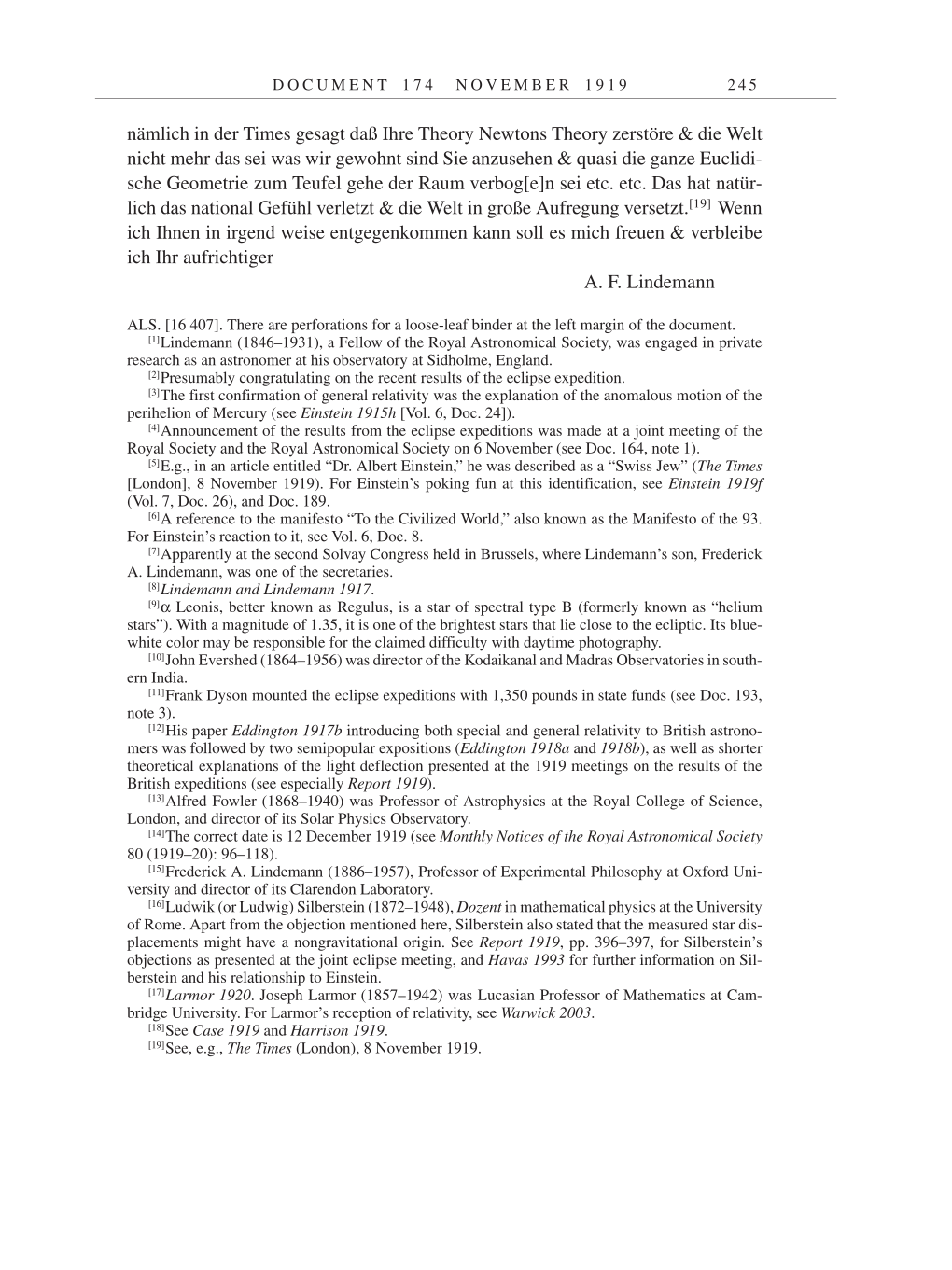D O C U M E N T 1 7 4 N O V E M B E R 1 9 1 9 2 4 5
nämlich in der Times gesagt daß Ihre Theory Newtons Theory zerstöre & die Welt
nicht mehr das sei was wir gewohnt sind Sie anzusehen & quasi die ganze Euclidi-
sche Geometrie zum Teufel gehe der Raum verbog[e]n sei etc. etc. Das hat natür-
lich das national Gefühl verletzt & die Welt in große Aufregung
versetzt.[19]
Wenn
ich Ihnen in irgend weise entgegenkommen kann soll es mich freuen & verbleibe
ich Ihr aufrichtiger
A. F. Lindemann
ALS. [16 407]. There are perforations for a loose-leaf binder at the left margin of the document.
[1]Lindemann (1846–1931), a Fellow of the Royal Astronomical Society, was engaged in private
research as an astronomer at his observatory at Sidholme, England.
[2]Presumably congratulating on the recent results of the eclipse expedition.
[3]The first confirmation of general relativity was the explanation of the anomalous motion of the
perihelion of Mercury (see Einstein 1915h [Vol. 6, Doc. 24]).
[4]Announcement of the results from the eclipse expeditions was made at a joint meeting of the
Royal Society and the Royal Astronomical Society on 6 November (see Doc. 164, note 1).
[5]E.g., in an article entitled “Dr. Albert Einstein,” he was described as a “Swiss Jew” (The Times
[London], 8 November 1919). For Einstein’s poking fun at this identification, see Einstein 1919f
(Vol. 7, Doc. 26), and Doc. 189.
[6]A reference to the manifesto “To the Civilized World,” also known as the Manifesto of the 93.
For Einstein’s reaction to it, see Vol. 6, Doc. 8.
[7]Apparently at the second Solvay Congress held in Brussels, where Lindemann’s son, Frederick
A. Lindemann, was one of the secretaries.
[8]Lindemann and Lindemann 1917.
[9]α Leonis, better known as Regulus, is a star of spectral type B (formerly known as “helium
stars”). With a magnitude of 1.35, it is one of the brightest stars that lie close to the ecliptic. Its blue-
white color may be responsible for the claimed difficulty with daytime photography.
[10]John Evershed (1864–1956) was director of the Kodaikanal and Madras Observatories in south-
ern India.
[11]Frank Dyson mounted the eclipse expeditions with 1,350 pounds in state funds (see Doc. 193,
note 3).
[12]His paper Eddington 1917b introducing both special and general relativity to British astrono-
mers was followed by two semipopular expositions (Eddington 1918a and 1918b), as well as shorter
theoretical explanations of the light deflection presented at the 1919 meetings on the results of the
British expeditions (see especially Report 1919).
[13]Alfred Fowler (1868–1940) was Professor of Astrophysics at the Royal College of Science,
London, and director of its Solar Physics Observatory.
[14]The correct date is 12 December 1919 (see Monthly Notices of the Royal Astronomical Society
80 (1919–20): 96–118).
[15]Frederick A. Lindemann (1886–1957), Professor of Experimental Philosophy at Oxford Uni-
versity and director of its Clarendon Laboratory.
[16]Ludwik (or Ludwig) Silberstein (1872–1948), Dozent in mathematical physics at the University
of Rome. Apart from the objection mentioned here, Silberstein also stated that the measured star dis-
placements might have a nongravitational origin. See Report 1919, pp. 396–397, for Silberstein’s
objections as presented at the joint eclipse meeting, and Havas 1993 for further information on Sil-
berstein and his relationship to Einstein.
[17]Larmor 1920. Joseph Larmor (1857–1942) was Lucasian Professor of Mathematics at Cam-
bridge University. For Larmor’s reception of relativity, see Warwick 2003.
[18]See Case 1919 and Harrison 1919.
[19]See, e.g., The Times (London), 8 November 1919.
